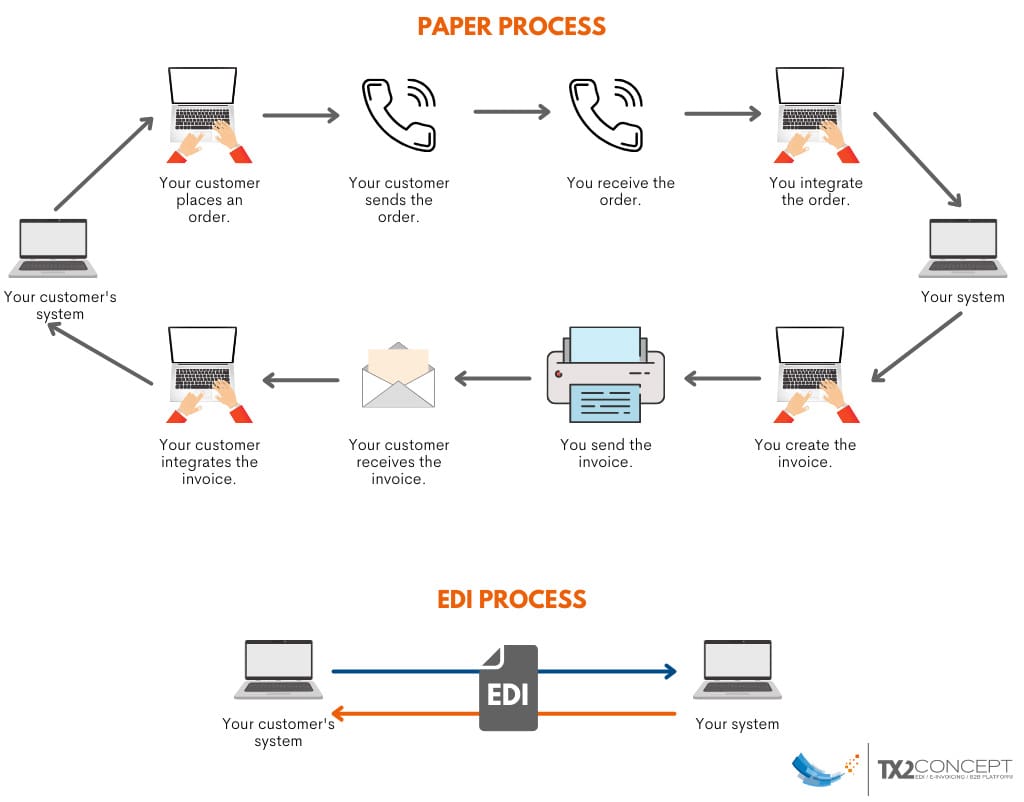Have you heard of EDI but do not fully understand what it is or how it works?
I know, some explanations of Electronic Data Interchange are complex and even barbaric for individuals with little IT knowledge. But don’t panic, in this article we will explain what EDI is all about in a simple and illustrated way so that it’s no longer a secret to you.
Simple definition of EDI
EDI according to INSEE
To begin with, here is the full definition of EDI according to the INSEE:
“Electronic data interchange (EDI) is a technique that replaces the physical exchange of documents between companies (orders, invoices, delivery notes, etc.) by exchanges, in a standardized format, between computers connected by dedicated links or by a (private) value-added network (RVA). The data is structured according to international technical standards (eg: Edifact). For example, the sending by fax of an order then its entry by an operator of the supplier company, is replaced by the transmission of information which is routed to a computer of the supplier company capable of interpreting the order.”
(Source: https://www.insee.fr/fr/metadonnees/definition/c1026)
In short, to do EDI you need a computer-to-computer connection. An EDI document then replaces the paper document with an electronic document. It also replaces emails. Even if an e-mail is sent electronically, the documents exchanged in this way must be processed by people and not directly by a computer.
This is the difference: through EDI, documents are transmitted directly to the business application (its ERP, for example) on the recipient’s computer. Their treatment begins upon receipt without human intervention. The definition of EDI indicates that this technology enables the exchange of business documents. By this we mean all of the day-to-day business-to-business documents such as purchase orders, invoices, shipping notices, stock statuses and more.
Standardization of exchanges
In order for these documents to be processed automatically by computers, it’s necessary to use a standard format. Thus, the computer is able to read and understand the document. For example, the standardized format indicates the type and form of data. It indicates whether the date should be in the form dd/mm/yyyy or mm/dd/yyyy.
Without this standardization, each company would use its own format, which would make it impossible for other computers to understand automatically. It’s like two people don’t speak the same language. It would be impossible for them to communicate without using a translator. In this case, EDI plays the role of translator. There are different standards that standardize EDI exchanges : EDIFACT, ANSI, TRADACOMS… Each of them has different versions. Therefore, when two companies want to switch to EDI, they must agree on the choice of standard and version.
This allows ERPs from both parties to be able to read this document. The EDI will then make it possible to translate the document of the sending company, which has its own internal format, so that it complies with the chosen standard. This document is then sent to the recipient and then translated again to be understandable by the internal system of this other company. As we said, EDI is none other than a translator.

EDI operation explained simply
As we have just seen, EDI messages use norms and standards. If a piece of data in a document, such as an invoice, was placed in the wrong place or if it was missing, then the EDI document could not be processed correctly by the recipient’s management system. These norms and standards are implemented by organizations such as GS1, ODETTE, TRADACOMS or even ASC X12. Usually, an organization is specific to an industry. ODETTE corresponds to the automotive sector, for example. Discover the main EDI standards.
Once the business partners agree on the standard to be implemented, the process can be broken down into 3 steps:
1. Preparation of documents
The first step is to collect and organize the data necessary to create the EDI document. For example, for an invoice, your system must create an electronic file containing the information necessary to create the invoice in EDI format. Several solutions are possible for the latter to have this data:
- A person enters the data on a computer
- Data is exported from a database
Other more technical solutions can be implemented such as the purchase of software with integrated interfaces for the creation of EDI files or the improvement of existing applications allowing the automatic creation of certain translatable files in EDI format. To find out more, we invite you to contact one of our experts who will be able to advise you according to your needs.
2. Translation of documents
Now that the internal document is created, all that remains is to translate it into the standard format defined upstream. To do this, it is possible to use EDI translation software purchased by the company. This implies having the in-house skills to manage and update it. It’s necessary to have mapping expertise to define how internal data will be associated with EDI data. It’s also possible to go through an EDI service provider. This is the choice made by the majority of businesses today. The service provider takes care of the translation of your documents in EDI format.
3. Connection and transmission of EDI documents
Your EDI documents are ready to be sent, but how should you send them to your partner? Several solutions are possible:
- Direct or point-to-point connection. A unique connection is then set up with each partner. This type of EDI is relevant between a customer and a supplier who exchange a large volume of documents on a daily basis.
- Connection via a value-added network (VAN). In this case, the network provider provides the sender and the recipient with a kind of electronic mailbox on which they can send and receive their EDI documents.
- Connection via a secure Internet communication protocol such as AS2. Data is exchanged securely over the Internet.
- The use of Web EDI. This type of EDI only requires a simple Internet connection. This is the preferred solution for VSEs and SMEs whose volume of EDI documents is not too large.
- Outsourcing of EDI. This is the solution chosen by the majority of companies because they who do not have the necessary internal resources. That’s why they prefer to turn to a specialized EDI service provider to manage their EDI environment on a daily basis.
Who can use EDI?
EDI can be useful to all companies and administrations exchanging commercial documents with their partners, regardless of their industry or size. There is an EDI solution suitable for every business.
However, your partners must be able to receive and process EDI documents in order to integrate them into their management system. At TX2 CONCEPT, we work mainly with players in retail, the automotive industry, transport, logistics and optics.
What are the advantages of EDI?
The benefits of EDI are many, which is why it’s the preferred means of communication for many businesses of all sizes. EDI document processing automation and direct data integration allow:
- Time saving and cost reduction. The processing that was done manually took time. Automation has made it possible to gain speed and thus reduce the cost of labour. Other costs related to paper, mailings, etc. also disappear.
- Improved efficiency and productivity. As documents are exchanged and processed faster, companies are able to exchange more in a shorter amount of time and with better accuracy.
- A reduction in errors. Indeed, as said before, EDI improves accuracy as it reduces the risk of human errors.
- Improved document traceability. No more risk of lost documents, which is very important in the event of a dispute. In addition, the direct integration with your ERP facilitates the visibility and analysis of documents.
- Improved commercial relations. All the advantages mentioned above make it possible to strengthen relations between trading partners. Fewer errors and delays, therefore fewer disputes, smoother and more secure communication… All of this promotes inter-company exchanges.
How to set up EDI?
To set up the EDI it’s necessary to start by auditing your current needs. This will allow you to choose the EDI solution that best suits your needs. At TX2 CONCEPT, we offer EDI solutions in SaaS mode or under license, as well as a Web EDI solution. It’s the situation of your company that will determine which of theses solutions is the most suitable. Our experts are there to advise you and support you in your project. Don’t hesitate to contact them for more information:
- Mail: commercial@tx2.fr
- Telephone: +33 2 38 69 65 43
- Contact form

